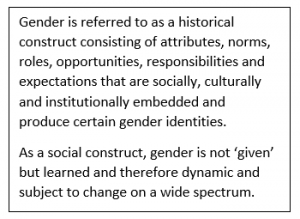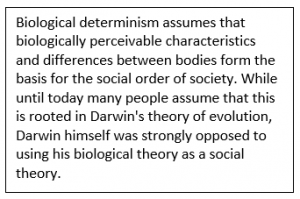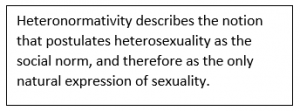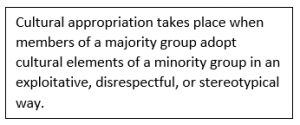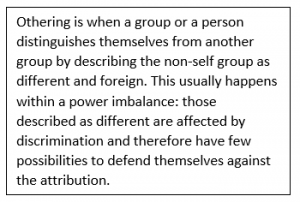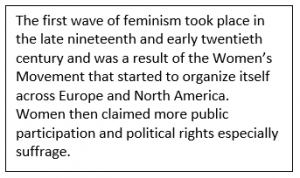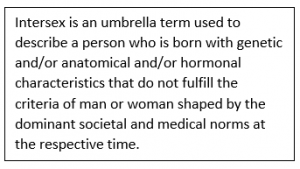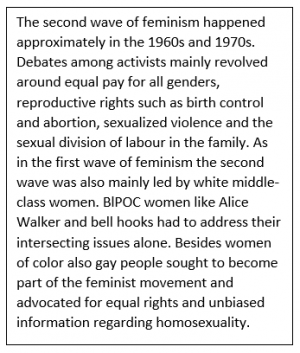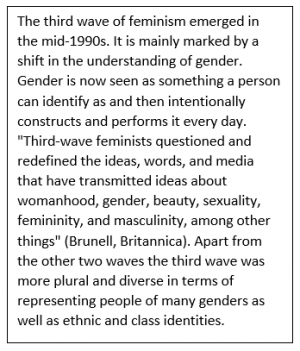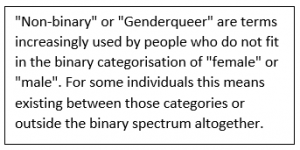Difference between revisions of "Gender First Aid Kit"
| Line 238: | Line 238: | ||
==Toilets== | ==Toilets== | ||
| − | Most toilets and changing rooms in public buildings, schools, restaurants and workplaces are divided into women and men only. Many inter*, trans*, non-binary and | + | Most toilets and changing rooms in public buildings, schools, restaurants and workplaces are divided into women and men only. Many inter*, trans*, non-binary and genderqueer people have discriminatory and violent experiences in such toilets and changing rooms because they visit a supposedly "wrong" toilet. For example, they report being misgendered, stared at or called names and asked intimate questions about their gender or body. Many therefore try to avoid going to the public toilet altogether by drinking as little as possible or only being in public spaces as often as absolutely necessary. |
| − | All-gender toilets and changing rooms pose a solution and safer space by providing access to all people, regardless of gender, with as little fear and discrimination as possible. | + | All-gender toilets and changing rooms pose a solution and '''safer space''' by providing access to all people, regardless of gender, with as little fear and discrimination as possible. |
Even though many universities in Germany for example started to build all gender toilets on their campuses, “gendered” bathrooms are still the norm. When entering those bathrooms, keep comments to yourself or if you witness a person calling out on another of whom they think doesn't belong there, inform them and be an ally. | Even though many universities in Germany for example started to build all gender toilets on their campuses, “gendered” bathrooms are still the norm. When entering those bathrooms, keep comments to yourself or if you witness a person calling out on another of whom they think doesn't belong there, inform them and be an ally. | ||
Revision as of 15:06, 30 May 2022
Contents
- 1 Introduction
- 2 History of Gender
- 3 Gender Neutral Language
- 4 Pronouns
- 5 Talking Behaviour
- 6 Toilets
- 7 Institutional commitment
- 8 References
Introduction
This Wiki article aims at giving a first and basic introduction to the topic of gender. Our intention is to offer some helpful tools and advice on how gender is important to consider in everyday life at university. We hope that students and teachers find helpful information and suggestions of how to act more aware regarding gender.
As this is meant to be a gender first aid kit we start this article by offering some practical advice on how to use gender neutral language and different pronouns as well as reflect on one’s own talking behaviour. After that we will describe the history of the concept of gender and thereby highlighting to you the most important information on the topic from our point of view. In the end, we will point out the relation of institutions such as universities with gender and explain why it is one important factor to consider while studying or working in an institution.
Disclaimer: The contents of this article require a very sensitive use of language and certain words. We as authors reflected upon that and want to share our thoughts with you before reading. During this article we will refer to and write about BIPoC (Black, Indigenous and People of Colour). We decided to rather use the term non-white people as this is more descriptive, and BIPoC is often used as empowering self-designation, which is why we as only white authors do not want to claim that. Furthermore, we are aware of our own privileged position regarding gender identity, social and academic background.
History of Gender
This section will provide a brief historical outline of how the concept of sex, and later gender, came into being from the 18th century onward until today. This is by no means a complete historical account but rather tries to give an introduction to the topic. The further links we provide might be a good starting point to deepen your knowledge if interested. We will mainly focus on the Enlightenment period in which natural sciences such as anthropology and biology emerged to explain the development of the sex binary and the differentiation of humans in races. After that, there will be a short summary of the four waves of feminism focusing on each’s main claims and developments regarding sex and gender. Furthermore, this historical section refers to the German/European/Western history of sex and gender and cannot be generalized to other societies, cultures and regions of the world.
Disclaimer: We decided to use the historical terms and meanings for sex and gender as they were used at the given time. By that we do not wish to reproduce the biological differentiation into women and men as right gender understanding but to increase the comprehensibility for the reader and to display the understanding of sex and gender at the respected historical time. Trigger warning: Throughout this chapter, references to racism and colonialism are being made. There are never detailed descriptions of racist violence.
The Enlightenment
Society in the 18th century was widely built upon a hierarchical system rooted in gender and race, which constructed social positions based on gender and racial differences. This separation of society into women and men and white and non-white people emerged during the Enlightenment which was an intellectual movement in the 18th century that strived for objective answers based on reason.
All people are equal?
Thus, the previous focus of society on religion and culture was tried to be replaced by reason. Based on the idea that all people are equal by nature, social, civil and universal human rights slowly evolved. An early example of these developments were the demands of European women for more rights, thereby questioning long-established social arrangements with respect to women’s rights and duties. This is now considered the first wave of feminism. The demands of women at the time raised the question of whether and how such changes in rights would be justified. In addition, it was unclear whether males of different skin colour had equal property rights and, in the course of this, how slavery could be continued, since the system was depending on injust labour force. A supposedly ‘scientific’ answer rooted in reason on how to justify the continuation of social inequality was needed (Eagle Russett 1989, Schiebinger 1993). "They were looking to nature for solutions to questions about sexual and racial equality. [...] Scientists took up the task of uncovering differences imagined as natural to bodies and hence foundational to societies based on natural law. [They] did not draw their research priorities and conclusions from a quiet contemplation of nature, but from political currents of their times" (Schiebinger 1993; 9,183). Under the pretext of reason and building on what was believed to be modern science, biological sexism and racism emerged, paving the way to biological determinism.
Biological determinism as social theory
Biological determinism and sex
Biological determinism and race
Exclusive science
The beard as a feeble indicator for superiority was already mentioned, yet over the next decades and centuries, further explanations to justify social inequalities were investigated. Criteria of inclusion and exclusion of certain people also applied to academic communities, creating a closed ingroup. Knowledge production thus consolidated itself as an exclusive white-male club, yet deprived itself of other perspectives, whose ideas and experiences were not considered valid. The white-male science of the time became restrictive in their theoretical and empirical focus. The division of people into the categories of male and female, white and non-white and the simultaneous establishment of a superiority of white males, argued through characteristics possessed only by them, led to the exclusion of non-white people from science (Schiebinger 1993). "European men, dominating academic science, increasingly tightened the reins on what was recognised as legitimate knowledge and who could produce that knowledge" (Schiebinger 1993, 142). While this Zeitgeist in science and society is now rightfully considered wrong, it is also relevant to mention the uncountable inequalities and injustices that got propelled out of that time.
The gender binary as a colonial object
Two-spirit
Hijra
Yorùbá
Colonisation and Christianisation
Since Colonisation was a multi-faceted process, main actors were not just statesmen who executed their orders from their European home countries. It was also missionaries who enforced a process of Christianisation in the colonies. Christian missionaries fulfilled the task of education on colonised land. The school often functioned as the church also was a place where the culture should be transformed to align with European values. Especially the family system was targeted with a focus on polygamy. “For the missionaries, having multiple wives was not only primitive but against God's law: polygamy was adultery, pure and simple” (Oyewumi 1997: 137). So the Christian education focused on conveying Western gender roles that were in their eyes more ‘civilised’. Besides learning to read the Bible children were taught skills and behaviour that suited their respective gender roles and expectations.
At this point, it must also be pointed out that Christianity was and is not the only religion that transported and exported certain ideas of gender, gender roles and sexuality with its spread. For example during the expansion of Islam starting around 800 throughout the Middle East and North Africa, but also to southern Europe, India, sub-Saharan Africa, Central Asia and Southeast Asia patriarchal and heterosexual norms were spread originating from Islam and Middle-Eastern traditions (Stearns 2015).
Waves of feminism
The whiteness of the first wave of feminism
Intersexuality and the deconstruction of the binary?
The personal is political and the second wave of feminism
Third wave of feminism and gender performativity
Fourth Wave of feminism and the joint fight
Take Home Message
In the 18th century, the concept of sex was created by natural scientists who applied self-selected differentiating characteristics on the basis of biological determinsm. After centuries of reflection on biases, systematic preconceptions, and oppression, parts of the scientific community came to the conclusion that neither sex nor gender are objective truths. Today, both sex and gender are considered socially constructed. What we have tried to show with this historical outline is that even supposedly scientifically produced knowledge is not objectively true but is permeated by social and cultural norms of the time. Scientific knowledge was and is used to justify policies and practices but one has to keep in mind that people have and still suffer because of these. As scientists, we therefore have an obligation to be critical of ourselves and of how we navigate this.
Further links
Colonialism
Hetero-patriarchy and Settler Colonialism: Ried Gustavson takes a two-spirited look at the effects of hetero-patriarchy on settler colonialism of indigenous peoples in the form of a TedTalk.
Pre-colonial attitudes to sex and gender fluidity: In this episode of On the Rag, host Leonie talks to Takatāpuhi activist Elizabeth Kerekere about pre-colonial attitudes to sex and gender fluidity.
Decolonising gender and sexuality in Wellington city: This video explores the Māoritanga and the nooks of the city of Wellington that allow them to thrive.
Gender
The Origin of Gender: This video tries to answer the question of "Why do we think there are only two genders when there are cultures that believe there are many more?" And "what’s the difference between sex and gender?".
The gender-fluid history of the Philippines: In much of the world, gender is viewed as binary: man or woman, each assigned characteristics and traits designated by biological sex. But that's not the case everywhere, says France Villarta. In a talk that's part cultural love letter, part history lesson, he details the legacy of gender fluidity and inclusivity in his native Philippines -- and emphasizes the universal beauty of all people, regardless of society's labels.
Alle für Alle: This German podcast by Dissens - Institut für Bildung und Forschung explores the current state of gender roles, masculinity, femininity, queerness and diversity from an anti-oppression, anti-hierarchies and profeminist point of view.
Gender diversity & identity in Queertopia: What does gender diversity and gender identity means nowadays? And what does gender diversity include? What if you are born with a body that does not meet society’s typical idea of ‘man’ or ‘woman’? Gender diversity has become more and more important and discussed. That´s why this documentary is investigating the world of gender diversity, identity and sexual diversity.
Theories of Gender: Crash Course Sociology: Why is gender even a thing? To answer that, this Crash Course video is going back to the three sociological paradigms and how each school of thought approaches gender theory. It looks at the structural functionalist view that gender is a way of organizing society into complementary roles, the symbolic interactionist take on how gender guides our daily life, and conflict theory’s ideas about how gender distributes power within society.
Queer : a graphic history: In this graphic novel, basic terminology regarding the field of Gender and Queer Studies is explained. From identity politics and gender roles to privilege and exclusion, Queer explores how we came to view sex, gender and sexuality in the ways that we do; how these ideas get tangled up with our culture and our understanding of biology, psychology and sexology; and how these views have been disputed and challenged. Along the way we look at key landmarks which shift our perspective of what's 'normal' - Alfred Kinsey's view of sexuality as a spectrum, Judith Butler's view of gendered behaviour as a performance, the play Wicked, or moments in Casino Royale when we're invited to view James Bond with the kind of desiring gaze usually directed at female bodies in mainstream media. Presented in a brilliantly engaging and witty style, this is a unique portrait of the universe of queer thinking.
Social Constructs: This video by Philosophy Tube neatly explains what lies behind the term "social construct" and why some people get so upset about it.
Glossary for gender and sexual diversity: Do you find yourself in a position of not knowing what a term within the field of Gender Studies means? This glossary has an answer to (most) of them. Note: this website is unfortunately only in German.
Feminism
Gender Neutral Language
What is gender neutral language?
“Gender-neutral language is a generic term covering the use of non-sexist language, inclusive language or gender-fair language. The purpose of gender-neutral language is to avoid word choices which may be interpreted as biased, discriminatory or demeaning by implying that one sex or social gender is the norm.“ (European Parliament 2018)
How is it used in different languages?
There are different strategies for using gender neutral language, depending on which language is spoken. In English, but also in some Scandinavian languages, many nouns are already gender neutral. The easiest strategy would be to reduce gender-specific terms as much as possible and thus to neutralise them. The European Parliament provides some examples of this: words that are not gender-specific and refer to people in general, with no reference to the person's gender (‘chairwoman’ or “chairman” is replaced by ‘Chair’ or ‘chairperson’, ‘policeman’ or ‘policewoman’ by ‘police officer’, ‘spokesman’ or “spokeswoman” by ‘spokesperson’, ‘stewardess’ or “steward” by ‘flight attendant’, ‘headmaster’ or ‘headmistress’ by ‘director’ or ‘principal’, etc.)” (European Parliament, 2018). In contrast, in German, but also in other Romance languages, it is not quite so simple as every noun has a grammatical gender and gender-related nouns occur very frequently. Usually, the generic masculine is used most of the time. Most nouns therefore have a masculine ending, especially in the plural. For example, we talk about Schüler, Bürger and Studenten. Many people do not question the generic masculine and accept it as 'normal' and 'correct'. However, it can be perceived as discriminatory by people who do not feel addressed and included by this generic. Moreover, psycho-lingual studies have shown that the way we phrase our sentences and what words we use shapes our reality. For example, when using only the generic masculine form to describe occupational titles, people imagine a male worker. This effect is especially crucial for children and their own perception of job status and self-efficacy (Vervecken & Hannover 2015). Thus, language is a tool to reinforce or counteract sexist, binary, and discriminatory structures and hence crucial to use carefully and with intent.
A variant of gender-neutral language or gender-sensitive language would be, on the one hand, to find a gender-neutral word for that noun, such as Studierende, Lehrpersonen, etc., or to gender it. There are now some well-known variants and various institutions already use them. For example, the generic masculine is no longer used, and there is no longer talk of Schüler and Studenten, but of Schüler*innen and Student*innen (other variants are, for example, with a ‘:’ or ‘_’ i.e., Schüler:innen or Student_innen). The advantage “des Gendern” and the use of gender-neutral terms over another strategy, namely the use of the feminine and masculine form such as Schüler and Schülerinnen or Studentinnen und Studenten, is that not only persons of the feminine and masculine gender are addressed, but also people that do not identify with one of the two binary genders.
Where to get some more help and advice?
The Leuphana Equal Opportunities Office has summarised some important and helpful tips for gender-sensitive language in German and links to other interesting sites that can make it easier to use gender-neutral language:
- Information about gender-sensitive language
- Working aid on gender-sensitive language
- genderleicht.de: Website with lots of helpful advice and tools on how to speak and write as less discriminatory as possible (German)
- Glossary with terms, persons, and organisations from Gender Studies and Diversity (German)
- Gendern - nervig oder notwendig?: A video in which psychologeek argues for and against the use of gender-sensitive language (German)
- Deutsches Lexikon für genderneutrale Personenbezeichnungen
More examples and tips on how to easily implement gender neutral language in English can be found here:
- United Nations guidelines for gender-inclusive language in English.
The following links are regarding gender-neutral language in Spanish, Arabic and French:
- Gender-neutral language in Spanish: Wiki entry by the Non-Binary Wiki, Video about gender-neutral language in Spanish
- Guidelines United Nations in Arabic Article about gender-neutral language in Arabic/English
- Guidelines United Nations in French
If you have not found your first/native language or preferred language here and would also like to get some insights into gender-neutral language in that language, just write as an email and we will try to add it.
Pronouns
What are pronouns? Why do they matter?
Pronouns are a way to refer to a person in a conversation besides using their name. Therefore, they are often intertwined with gender identity. Using the right pronouns when talking about another person acknowledges and validates their identity and shows acceptance and respect for the other person.
There are different pronouns commonly used, for example she/her, he/him or they/them. However, pronouns are not limited to just these terms. People can use multiple sets of pronouns (e.g., she/they), which shall be used interchangeably when referring to this person. Additionally, neopronouns e.g. xe, thon, ens or dey (in German) have been on the rise especially for non-binary and genderqueer people. Learning how to use and conjugate them is a way of showing that you care. In the German language, there is no established gender neutral pronoun yet. Thus, using no pronouns and simply being addressed by one’s name is common.
It is important to remember that gender expression is not the same as gender identity. The way a person presents (for example by wearing certain clothes or make-up) does not say anything about what pronouns they use and what their gender identity is, meaning you cannot visually tell what a person's gender is. Hence, a person can present in a traditionally feminine way and identify as non-binary and use they/them pronouns.
How to ask for pronouns
When meeting new people, an easy way to let people know your pronouns is by introducing yourself with your name and your pronouns (e.g. Hello! My name is ... and I use .../... pronouns. Nice to meet you.). It may feel a little weird and unfamiliar at first, but the more you do it the more it will become normal and natural. Furthermore, it often leads to the other person introducing them with their pronouns as well. If not, you can kindly ask for it ("What pronouns do you use?"). Especially for cisgender people, introducing oneself with pronouns is a good sign of showing awareness and being an ally to transgender/genderqueer/non-binary people since it contributes to normalising this process and helps to reduce assuming pronouns based on appearance.
If you have already met a person but are unsure of their pronouns it is okay to ask for them again or at a later point. It might be convenient to do so in a more private setting and not in front of a group to take away pressure. This applies to the usage of pronouns you don't know as well. It is always better to ask for clarification respectfully than to assume and/or use wrong pronouns.
Sometimes, what pronouns or names people want to be addressed with may vary due to contexts and feelings of safety. If possible, ask people beforehand.
What (not) to do when messing up
If you accidentally use the wrong pronoun for a person, it is important to correct yourself. This shows your respect for the other person and their identity. A correction and a short apology may look like this: "“He likes – I’m sorry, they like noodles more than rice." Making excuses however can be frustrating - therefore avoid doing so. We propose a similar approach when someone else corrects you: thank them for doing so and move on with your sentence using the correct pronoun - don’t react offended if someone informs you that you have used the wrong pronouns.
If you notice another person using wrong pronouns, speaking up is a good way to show solidarity and awareness. However, it is important to keep in mind that this should be at the comfort of the affected person.
Be trustworthy!
If you know a name or pronoun a person has previously used, keep it to yourself. Try to avoid situations, especially in public, where a person is pressured to reveal their “dead name” (=old name), email-addresses, letters, IDs ...
For teachers
You as a teacher are in a position to set a positive example for your students. Sensitivizing them for discriminating language, behaviour, working environment etc. is important (as this entry hopefully has shown).
However, there is more you can do to actively create a safer environment for all: •Give students a chance to let you know if their name and pronouns differ from their legal documents used in the registration process e.g by having an introduction round in which everyone can write down their preferred name and pronouns on a nameplate However, respect if they remain silent!
•Include a chance to communicate other needs which are important for their participation, for example accessibility. (Both points can be mentioned in an email that goes out to all students before the first class)
•Go through attendance lists without "Mr/Mrs. + first name" but simply read down last names to avoid dead naming or assuming the wrong gender
•Address students in the seminar with their first name and not with Mr/Mrs + last name
Links & further reading
All about pronouns: Ash Hardell in this YouTube Video introduces you to pronouns as well as neo-pronouns.
They/them pronouns in popculture:
- Cal in Sex Education (Netflix series) time stamp: 18:04-19:17
- Adira in Star Trek
- One day at a time (Netflix series) time stamp: 0:00-2:25, 5:36-6:40
Online game:Here you can learn how to conjugate (neo)pronouns.
Neopronoun guide: A guide that introduces you to the different kinds of neo-pronouns and how to use them.
Pronouns: Interview of people by the channel Cut and the meaning of pronouns to them.
Talking Behaviour
Language matters. It is very important within any form of institution and group setting to be aware of the respective ripples that language may create, for example reinforcing power imbalances regarding gender, race or class. Therefore, reflecting on your own usage of language, talking behaviour, and role within a group is important. There shortly will be a whole Wiki entry regarding this topic, however here is a summary worth looking at.
Reflexive questions for students
•Am I contributing to the whole group in a balanced way?
•What is the experience of other people, and do I perceive and include their experiences?
•Do I presuppose experience or knowledge that not all people have?
•Is my language inclusive and respectful?
•Do I try to avoid stereotypes?
•Am I repeating arguments someone else has already said?
•How do I respond to criticism? Do I feel the direct urge to comment on it or can I just listen to it first?
•How do I voice criticism towards others?
•Which gestures do I use while talking? How might these affect others?
•How is my talking time in comparison to others?
•Is my experience representative for most/ all?
Reflexive questions for teachers
•Are there certain structures in the seminar that contribute to the fact that certain groups of people predominantly speak up? How diversity-sensitive is the design? (e.g. one-sided methodology, no consideration of different learning types, gender-sensitive language, which texts by which authors are being read?)
•Is the setting of the group meeting inclusive, empowering, fosters diversity and builds on diverse learning strategies and needs?
•Are people interrupting others, or dominating the group? How am I responding to this?
General tools
•(Quoted) list or round of speakers
•Code of conduct
•Reflexive rounds to share perceptions within the group
•Moderators
•Protocol of the discussion, including a sharing of this protocol among participants and the possibility for edits.
•Recording with an app, given that everybody agrees.
•Anonymous feedback tool
Toilets
Most toilets and changing rooms in public buildings, schools, restaurants and workplaces are divided into women and men only. Many inter*, trans*, non-binary and genderqueer people have discriminatory and violent experiences in such toilets and changing rooms because they visit a supposedly "wrong" toilet. For example, they report being misgendered, stared at or called names and asked intimate questions about their gender or body. Many therefore try to avoid going to the public toilet altogether by drinking as little as possible or only being in public spaces as often as absolutely necessary. All-gender toilets and changing rooms pose a solution and safer space by providing access to all people, regardless of gender, with as little fear and discrimination as possible.
Even though many universities in Germany for example started to build all gender toilets on their campuses, “gendered” bathrooms are still the norm. When entering those bathrooms, keep comments to yourself or if you witness a person calling out on another of whom they think doesn't belong there, inform them and be an ally.
As advice for teachers, if all gender toilets are not common in every building, point out where the next one is. Also, be aware that people who go to the toilet during the lecture or seminar have every right to do so. They can have any reason why seeking to go to the bathroom is valid, be it wanting to go when toilets are not too frequented or needing to due to menstruation. Please avoid asking them to go during the break instead.
Reflexive questions while visiting the next public bathroom
•For whom are bathrooms a safe space, who is excluded?
•Whose needs are respected there?
•Which norms are reproduced by the signs/names of the bathrooms?
•Are there toilets for all genders, barrier-free ones, ones accessible for all with diaper changing tables?
•How much time does it take to reach them and are break times thus appropriate? (especially for teachers)
•Are there bins for sanitary products in all toilets and if not, which assumption about people who menstruate is thus reproduced?
Institutional commitment
Within most constructed institutions, the legal status concerning gender is focusing on inequalities related to the differences between women and men. These societal constructed categories are for sure not the only categories that create inequalities and injustices (see Intersectionality), but most constructed institutions to this day unfortunately focus on these specific inequalities and injustices. There are other legal changes currently happening in some countries that take other viewpoints and a more diverse understanding into account, yet these changes are slow, often singular, and by a lack of implementation even a backlash. Since 1st January 2019, ‘divers’ has been a third positive gender entry in German civil status law alongside ‘female’ and ‘male’. In addition, it is also possible to have ‘no gender’ registered. However, this change of gender entry is currently only available to intersex persons. This also expands the understanding of gender that institutions base their gender equality work on. But there are also other developments happening creating a backlash in LGBTQ+ rights. A couple of weeks ago the state of Florida in the US passed a law titled ‘Parental laws in Education’. In the media it got popular with the name ‘Don’t say gay bill’. The new law seeks to ban discussion of gender and sexuality issues from schools. A separate analysis by the CNN journalist Giselle Rhoden found that in the current legislative session around 150 anti-LGBT bills have been introduced at the state level. They range from restricting access to gender-affirming health care for minors to excluding transgender children from athletics.
The structures and mechanisms in constructed institutions -such as universities- are often slow to adapt to societal changes. And yet, universities as center for innovation, should lead the way also to this end. What is however often happening is that the legal situation became more and more complex over time, and the adaptability decreased. This should not be the case, and it is clear to recognize that we are part of a continuous change where we have already come a long way. However, even within diverse institutions the legal ramifications are lacking behind what we perceive to be the baseline of societal change. An example of this is the dgti supplementary ID. The dgti supplementary ID is a standardised identity document that documents all self-selected personal data and shows a current passport photo. This is helpful because for trans* persons the official identity documents do not match their own gender identity before the official change of name and/or civil status. Similarly, this can also be the case with external appearance. This often leads to unpleasant, stressful and humiliating questions or even dangerous situations during a personal check. The dgti ID card is already known and accepted by some banks, universities, insurance companies and others but not everywhere since it is voluntary and not obligatory to accept it.
It is not ok that the people who live this change are reduced to their specific identity, while the institution does not recognise their identity as they perceive it. We are committed to try to change the institutions as they currently are and are equally committed to support each other in creating this change.
Where to turn for advice in our institution?
The ombudsperson for students and lecturers is responsible for the internal communication with the University's management and administration. Furthermore, the Ombudsperson listens to the ideas, suggestions and problems expressed by the teaching staff and students, and acts as a mediator between the University's various stakeholder groups. The Ombudsperson offers the possibility of dealing with concerns anonymously, confidentially and in all neutrality, and can contribute to the resolution of personal conflicts on the basis of mediation.
Office for Equal Opportunities.
The Office for Equal Opportunities coordinates measures to promote equality and diversity at Leuphana University. It develops measures for the advancement of women as well as antidiscrimination strategies. The Office for Equal Opportunities is committed to the goal of creating a pleasant study, work, career and research environment for all members of Leuphana University and actively supports a diverse and family-friendly university culture.
The information portal "Against Sexual Harassment", which is managed by the Equal Opportunities Office, offers information material on prevention as well as an overview of contact and support options in cases of sexualised discrimination and violence at Leuphana and beyond.
- Other Contact Points and Counselling Services are listed here by the Office of Equal Opportunities.
Student Representation (AStA).
ARCHIPEL stands for "Autonomes Referat für Chronische Erkrankungen, Handicaps und Inklusion, Psychische Erkrankungen, Empowerment und Lernbeeinträchtigungen" (Autonomous Unit for Chronic Illnesses, Handicaps and Inclusion, Mental Illnesses, Empowerment and Learning Disabilities). The unit is committed to an inclusive everyday study life and the dismantling of structural barriers and offers a platform for exchange and diverse opportunities to participate. Contact at archipel@asta-lueneburg.de
The AStA's anti-racism department aims to address racist and discriminatory structures and work together with the student body to combat them. Contact at antira@asta-lueneburg.de
QuARG stands for Queer, Awareness, Equal Rights and Gender Matters. The unit deals with everything that revolves around the topics of gender and sexuality. This includes homosexuality, bisexuality, heterosexuality and asexuality, as well as intersex/intersexuality and trans*identity, and feminism, sexism and queerness.Contact at quarg@astalueneburg.de
- Student anti-discrimination officer.
The student anti-discrimination officer can be contacted in case of discrimination experience as a student at University. The person will try to offer help as best as possible with advice, assists in the communication with the university or just listens to experienced problems. Contact at Antidis@asta-lueneburg.de
References
Butler, Judith (1990). Gender Trouble: Feminism and the Subversion of Identity. New York: Routledge.
Crenshaw, Kimberlé (1991). Mapping the Margins: Intersectionality, Identity Politics and Violence against Women of Colour.
Combahee River Collective. (1977). The Combahee River Collective Statement. In K.-Y. Taylor (Publ.), How we get free. Black Feminism and the Combahee River Collective (pp. 15–27). Haymarket Books.
Cameron, Michelle (2005). Two-spirited Aboriginal People: Continuing Cultural Appropriation By on-Aboriginal Society. Canadian Women’s Studies, 24(2), 123-127.
Eagle Russett, Cynthia (1989). Sexual Science. The Victorian Construction of Womanhood. Harvard University Press.
European Parliament (2018). Gender Neutral Language in the European Parliament.
Fausto-Sterling, Anne (2000). Sexing the Body. Gender Politics and the Construction of Sexuality.
Gillis, Stacy; Howie, Gillian & Munford, Rebecca (2004). Third Wave Feminism A Critical Exploration.
Gill-Peterson, Julian (2018). Histories of the Transgender Child. Minnesota University Press.
Hinchy, Jessica (2022). Obscenity, Moral Contagion and Masculinity: Hijras in Public Space in Colonial North India. Asian Studies Review, 38:2, 274-294, DOI: 10.1080/10357823.2014.901298
Hussain, Salman (2019). State, gender and the life of colonial laws: the hijras/khwajasaras’ history of dispossession and their demand for dignity and izzat in Pakistan. Postcolonial Studies, 22:3, 325-344, DOI: 10.1080/13688790.2019.1630030
Newman, Louise M. (1999). White Women’s Rights. The Racial Origins of Feminism in the United States. Oxford University Press.
Orr, Catherine M. (1997). Charting the Currents of the Third Wave.
Oyewumi, Oyeronke (1997). The invention of Women. Making an African Sense of Western Gender Discourses. University of Minnesota Press.
Schiebinger, Londa (1993). Nature’s Body. Gender in the Making of Modern Science. Rutgers University Press.
Schuller, Kyla (2018). The biopolitics of feeling: race, sex, and science in the nineteenth century. Durham, NC: Duke University Press.
Stearns, Peter N. (2015): Gender in World History. Third Edition. Routledge Taylor & Francis Group.
Vervecken, Dries & Hannover, Bettina. (2015). Yes I Can!. Effects of Gender Fair Job Descriptions on Children’s Perceptions of Job Status, Job Difficulty, and Vocational Self-Efficacy. Social Psychology.
